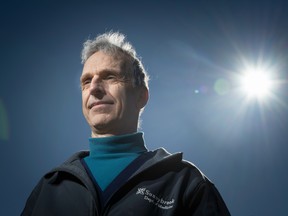Canadian research suggests the risk of a fatality from a vehicle crash every 95 minutes from people rushing to view the celestial event
Article content
Sunburned retinas aren’t the only potential risk from a solar eclipse.
New research suggests the total solar eclipse on April 8 could lead to about one extra person involved in a vehicle crash every 25 minutes, and one extra crash fatality every 95 minutes.
Article content
The study is based on data from a registry of fatal traffic crashes on public roads in the U.S. Canadian researchers focused on a three-day “exposure interval” centred around the day of the last total solar eclipse, in August 2017 — the day before, the day of and the day after.
Advertisement 2
Article content
The riskiest crash times weren’t during the few minutes of totality, when the moon completely obscured the sun “and everything is black,” said lead investigator Dr. Donald Redelmeier.
“Au contraire. It’s in the hours before and especially the hours after,” when people are rushing to get to prime celestial viewing spots on time or rushing to get back home, Redelmeier said. The single riskiest hour was between 6 pm and 7 pm on the evening of the eclipse, “so, well after it was over.”
During the 2017 eclipse, “a major, immediate, post-eclipse exodus” snarled traffic and extended travel times by up to 13 hours on American roadways and interstate routes leading away from the path of totality, Jonathan Upchurch, professor emeritus at Arizona State University wrote in 2018 in TR News, a publication of the National Academies of Sciences, Engineering and Medicine.
As one Kentucky newspaper headline noted: “The rare eclipse was memorable. The ride home was something they want to forget.”
This year’s total solar eclipse may attract even greater interest, Upchurch predicted back in 2018. “Many first-time viewers will attend the 2024 eclipse because of what they heard from those who saw the eclipse in 2017. The event also will have a high number of repeat participants.”
Article content
Advertisement 3
Article content
One million people are expected to flock to Niagara Falls alone, where the sun will be fully eclipsed at approximately 3:18 EDT and will last for approximately three minutes. Kingston, Ont. is preparing for an influx of 500,000 visitors.
The total solar eclipse will traverse North America, passing over Mexico, the United States and Canada. The path of totality will sweep along Highway 401 from Port Hope to the Quebec border. In Quebec, the south part of Montreal will experience totality, while in New Brunswick, Fredericton and Mirimachi will be prime viewing locations. The path will then head across Newfoundland, although it will pass north of St. John’s.
Redelmeier practices medicine at Sunnybrook Hospital, home to Canada’s largest trauma centre and where he and his colleagues noticed that “those snazzy eclipse sunglasses do not always offer adequate protection against solar retinopathy (vision damage from staring at the sun) and offer zero protection against other potential risks from an eclipse,” he said.
Notably, the surge in traffic. “The eclipse leads to a lot of driving, a lot of traffic,” he said, similar to Thanksgiving, or Memorial Day and the July 4th weekend in the U.S.
Advertisement 4
Article content
The eclipse leads to a lot of driving, a lot of traffic
Dr. Donald Redelmeier
During the total solar eclipse on August 21, 2017, the path of totality was about 113-kilometres wide and fell within 300 miles of driving distance “for a third of all individuals in the U.S.,” Redelmeier and his co-investigator, Dr. John Staples, a clinical associate professor in the department of medicine at the University of British Columbia, write in a research letter published today in JAMA Internal Medicine.
“An estimated 20 million people in the U.S. travelled away from home to another city to view the eclipse, resulting in substantial road traffic.” This year, several major centers, including the Greater Toronto Area, are within a three-hour drive of the path of totality for the Apr. 8 total eclipse.
For their study, Redelmeier and Staples obtained data from the National Highway Traffic Safety Administration Fatality Analysis Reporting system.
They focused on Aug. 19, 20 and 21 of 2017, and compared it to three-day control intervals a week before, and a week after, the eclipse (Aug. 13 14 and 15, and Aug. 27, 28 and 29), matching by day of week. “And then we add up the tombstones at the end of each interval,” Redelmeier said.
Advertisement 5
Article content
They used an official U.S. Navy calculator to categorize crash timing, relative to the moment of maximal eclipse, based on location latitude and longitude.
A total of 741 people were involved in fatal crashes over the three-day eclipse exposure period, and 1,137 over the six control days.
“On the eclipse days, it averages out to just over 10 deaths (from traffic crashes) per hour, whereas a normal day averages out to slightly less than eight deaths per hour,” which corresponds to a 31 per cent relative increase in traffic risks around the time of the eclipse, Redelmeier said.
It’s difficult to attribute the increased traffic risks solely to “transient changes in ambient light, they said. Instead, it’s likely due to the sheer increase in traffic.
“Other potential factors including travel on unfamiliar routes, speeding to arrive on time, driver distraction by a rare celestial event, drug- or alcohol-induced impairment from eclipse-related celebrations and eclipse viewing from unsafe roadside locations.”
Most crashes occurred about two to four hours driving distance away from the path of totality. “It’s not when you first put your key into the ignition, but two to four hours later. That’s the greatest danger moment.”
Advertisement 6
Article content
Most crash victims were occupants of the vehicle, as opposed to pedestrians or other roadside gazers.
There are several limitations. “First, we’ve got no data on individual driving distances, so that our average results may underestimate the effects on those who are driving longer trips,” Redelmeier said.
The data also don’t distinguish between those who watched the eclipse from those who were completely uninterested bystanders “and are just swept up in the aftermath of a traffic crash. Because we all share the road, so just because you’re not paying attention to the eclipse, you have to pay attention to every other driver that surrounds you.”
The authors also looked at fatal crashes only, and not those that led to minor injuries or property damage, though Redelmeier suspects the increased relative risk would apply across the spectrum of severity, “but there’s no way we can know that for sure.”
To help prevent another possible surge in traffic fatalities during April’s celestial spectacle, people need to be mindful of basic traffic safety, they said: respect speed limits, minimize distractions, allow for greater headway (space) between cars, wear seatbelts and never drive while impaired.
Advertisement 7
Article content
In a video posted to X, the head of the U.S. Federal Highway Administration also warned the millions of people planning to travel to the path of totality not to watch the eclipse while driving and not to stop on the highway shoulder.
The findings, however, may be part of a larger phenomenon. “There are about 20 per cent more traffic fatalities during the afternoon commute, coming home from work, than during the morning commute,” Redelmeier said.
“The roadways, the vehicles, the drivers being the same, it’s the pattern of just letting down your guard after a major event (like leaving work). That doesn’t just occur once a year That occurs every day.”
To prevent eye damage, safe solar viewers should comply with the ISO 12312-2 international standard, according to NASA, though even glasses carrying that “certification” can be counterfeit. Torn, scratched or otherwise damaged eclipse glasses should be thrown away.
Recommended from Editorial
Our website is the place for the latest breaking news, exclusive scoops, longreads and provocative commentary. Please bookmark nationalpost.com and sign up for our newsletters here.
Article content














